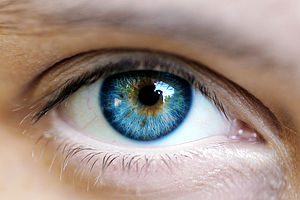Eyes
Description of Niche
Where located?
Physical Conditions?
What are the conditions in your niche? Temperature, pressure, pH, moisture, etc.
Influence by Adjacent Communities (if any)
Is your niche close to another niche or influenced by another community of organisms?
Conditions under which the environment changes
Do any of the physical conditions change? Are there chemicals, other organisms, nutrients, etc. that might change the community of your niche.
Tears
Tears Tears are secretion from tear glands to lubricate and protect eyes from infection. The tear film allows gas exchange between the air and the epithelium and also keeps the cornea wet. The substance of the tear film is retinol to provide the transparent nature of the epithelium. (1) Tears are composed of water, electrolytes, proteins (albumin, globulin, and lysozyme), lipid, mucins and others. They are weak base. (2)
Tear production system The protection of tears has three separate layers: the lipid layer, the aqueous layer, and the mucous layer. The outermost lipid layer contains oils produced by the meibomian glands. It is a thin layer (0.1-0.2 and hydrophobic surface, so it reduces evaporation of water. The temperature in meilbomain gland lipids has the low melting point range 19-32C depending on the degree of fatty acids unsaturation. The meibomain gland lipids allow lipid get through the meibomian gland ducts and excretion to the tear film. The aqueous layer is a tear film including water and proteins produced by the lacrimal gland. The middle layer of the lacrimal gland is the thickest (7-8m) and produces 0.9% saline tears. It functions delivery the main nutrients such as oxygen to the cornea and carrying waste products away from the cornea The innermost mucous layer (30m) contains mucin produced by goblet cells. Its thin layer of hydrophilic surface can make even on the corneal surface to spread water. (1,2,3 and 5)
Many species of bacteria are found in the eyelid and conjunctiva as symbiotic relationships. These are Staphylococcus aureus (S. aureus), Staphylococcus epidermidis, Streptococcus, Corynebacterium, Propionibacterium, and Propionibacterium acnes. These bacteria produce lipase that harm to the tear film lipid layer especially, S. epidermidis and S. aureus produce triglyceride lipase and cholesterol and wax esterase. Accumulated cholesterol is used for the growth of certain ocular bacteria. Increased bacteria are regulated by anti-microbial peptides from the lacrimal gland and conjunctiva. (6)
http://physiologyonline.physiology.org/cgi/content/full/13/2/97 (1) http://www.nature.com/eye/journal/v17/n8/full/6700566a.html (2) http://www.tedmontgomery.com/the_eye/cornea.html (3) http://www.lea-test.fi/en/eyes/lidsncha.html (4) http://bjo.bmj.com/cgi/content/abstract/68/8/524 (5) http://www.sciencedirect.com/science?_ob=ArticleURL&_udi=B6WFD-49H6Y6X-1&_user=10&_rdoc=1&_fmt=&_orig=search&_sort=d&view=c&_version=1&_urlVersion=0&_userid=10&md5=cae06adc263756d8bb890e5f40005b89#toc1 (6)
Who lives there?
Which microbes are present?
You may refer to organisms by genus or by genus and species, depending upon how detailed the your information might be. If there is already a microbewiki page describing that organism, make a link to it.
Fungal Infestation into the Eye Niche
The warm and moist environment of the eye is subject to mycotic infections from fungal microbes such as Fusarium, Aspergillus, Acremonium, and Candida yeasts. Due to the preferences for moisture-rich environments and warm weather, the prevalence of fungal infections of the eye is higher in tropical areas and in areas with large agrarian communities. Despite the relatively sterile environment of the eye, factors such as eye “trauma (generally with plant material, chronic ocular surface diseases, contact lens usage, corneal anesthetic abuse and immunodeficiencies” can result in infection of the eye by filamentous fungi or yeasts. Fusarium solani, a species of fungi that is associated with contact lens wearers, normally inhabits warmer climates in soil and organic matter. Invasion of the inner layers of contact lenses and ultimately the infection of the eye is possible due to the ability of Fusarium solani to reside in the water-rich inner matrix of soft contact lenses. Fungal infections, such as fungal keratitis, can occur on the anterior surface of the eye or the cornea, and may also infect the posterior of the eye as a result of mycosis. Fungi that inhabit the eye produce proteases that are specific for the surface on which they grow. As a result, protein catabolism by fungal proteases results in tissue damage to the eye, ulceration as well as an inflammatory response around the infected area. Aggregation of fungal microbes into hyphae enlarges the infected region and prevents host inflammatory cells from ingesting the fungi. As a result of the pattern of fungi to join together and form hyphae, fungi that inhabit the eye may extend throughout the entire depth of the cornea, and tend to grow parallel to the lamellae of the cornea. As a result of catabolic degradation of the eye environment by the fungi, an inflammatory response by the host is accompanied by coagulative necrosis of the surrounding eye tissues. Fungal infection of the eye may occur as a result of fungal growth on contact lenses. Due to tendency of fungi to inhabit moisture-rich locations, contact lens cases and the soft inner matrix of contact lenses are subject to fungal growth. Fungi have the ability to degrade hydrophilic polymers of contact lenses, and may be transferred from contaminated lenses to the anterior surface of the eye, often causing the implantation of fungi into the anterior regions of the eye or the cornea and result in fungal keratitis.
Do the microbes that are present interact with each other?
Describe any negative (competition) or positive (symbiosis) behavior
Do the microbes change their environment?
Do they alter pH, attach to surfaces, secrete anything, etc. etc.
Do the microbes carry out any metabolism that affects their environment?
Do they ferment sugars to produce acid, break down large molecules, fix nitrogen, etc. etc.
Current Research
Enter summaries of the most recent research. You may find it more appropriate to include this as a subsection under several of your other sections rather than separately here at the end. You should include at least FOUR topics of research and summarize each in terms of the question being asked, the results so far, and the topics for future study. (more will be expected from larger groups than from smaller groups)
References
(1) http://physiologyonline.physiology.org/cgi/content/full/13/2/97 (2) http://www.nature.com/eye/journal/v17/n8/full/6700566a.html (3) http://www.tedmontgomery.com/the_eye/cornea.html (4) http://www.lea-test.fi/en/eyes/lidsncha.html (5) http://bjo.bmj.com/cgi/content/abstract/68/8/524 (6) http://www.sciencedirect.com/science?_ob=ArticleURL&_udi=B6WFD-49H6Y6X-1&_user=10&_rdoc=1&_fmt=&_orig=search&_sort=d&view=c&_version=1&_urlVersion=0&_userid=10&md5=cae06adc263756d8bb890e5f40005b89#toc1

